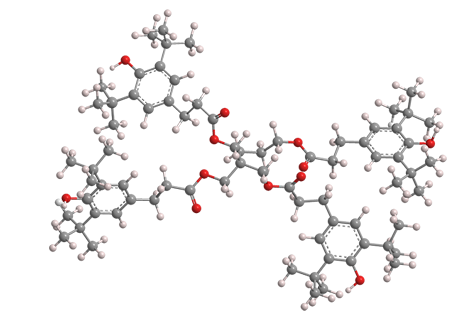What molecule am I?


Pentaerythritol tetrakis[(3,5-di-tert-butyl-4-hydroxyphenyl)propionate]1 (PBHP) is a stabilizer and antioxidant for organic compounds and polymers. In US Patent 3,285,855 (1966) to Geigy Chemical (then in Greenburgh, NY), inventors Martin Dexter, John D. Spivack, and David H. Steinberg describe PBHP and similar compounds as stabilizers against oxidation for hydrocarbons, lubricating oils, and polymers such as polypropylene, polystyrene, and polyethylene.
Since the mid-1960s, PBHP has found many uses, as exemplified by its more than 48,000 entries in SciFinder. In 2023 US Patent Application 2023/0279212 to Trinsco Europe GmbH (Horgen, Switzerland), inventor Jiaxin Jason Ge mentions it as a stabilizer for acrylic copolymer resins.
In the chemical industry, PBHP is perhaps best known by its BASF trade name Irganox 1010. A BASF data sheet for industrial coatings describes Irganox 1010 as “a highly effective, non-discoloring, sterically hindered primary phenolic antioxidant stabilizer that protects organic substrates against thermo-oxidative degradation.”
PBHP also has medical applications. In a 2021 publication by DePuy Sythes2 (Warsaw, IN), Elizabeth Hippensteel and Bharat Patel wrote that blending PBHP into ultrahigh molecular weight polyethylene for total hip arthroplasty “offers potential advantages, including long-term oxidative stability of the implant, improved wear properties, and potential for improved mechanical properties.”
PBHP is insoluble in water but highly soluble in acetone, ethyl acetate, dichloromethane, and chloroform, making it easy to incorporate into almost any organic material.
1. SciFinder: benzenepropanoic acid, 3,5-bis(1,1-dimethylethyl)-4-hydroxy-, 1,1′-[2,2-bis({3-[3,5-bis(1,1-dimethylethyl)-4-hydroxyphenyl]-1-oxopropoxy}methyl)-1,3-propanediyl] ester.
2. DePuy Synthes is the orthopedics subsidiary of Johnson & Johnson.
PBHP hazard information
| Hazard class* | GHS code and hazard statement |
|---|---|
| Not a hazardous substance or mixture |
*Globally Harmonized System (GHS) of Classification and Labeling of Chemicals.
Molecules from the journals
Syrosingopine1 is an anti-hypertension medication that was introduced by former drug company CIBA in 1960. R. A. Lucas and co-workers at CIBA’s research department in Summit, NJ, synthesized syrosingopine from the earlier hypertension drug reserpine2 in 1958.
This past November, Yuki Hitora, Sachiko Tsukamoto, and colleagues at Kumamoto University (Japan) reported another beneficial use for syrosingopine. They found that the molecule activates the 20S proteasome, which degrades intrinsically disordered proteins (IDPs). The aggregation of IDPs is a cause of neurodegenerative diseases.
Carbamic acid3 (NH2CO2H), also known as aminoformic acid, is the simplest amine carboxylic acid. It has been known since at least 1882, when H.J.H. Fenton at the University of Cambridge (UK) mentioned it in an article about the conversion of urea to cyanamide. Carbamic acid is formed by the reaction of ammonia (NH3) with carbon dioxide (CO2) at low temperatures and is unstable above –23 °C.
Carbamic acid is of no practical use on Earth, but it might tell us something about the origin of life in interstellar space. In November, Agnes H.-H. Chang at National Dong Hwa University (Hualien, Taiwan), Ralf I. Kaiser at the University of Hawai’i at Manoa (Honolulu), and collaborators reported that this potential progenitor of amino acids is likely to exist in interstellar ices. In laboratory simulations of conditions at which ices form, they found that the lower limit for the formation of carbamic acid from NH3 and CO2 is 62 ± 3 K (–211 ± 3 °C). The authors suggest that the James Web Space Telescope and the Atacama Large Millimeter Array should be able to detect existing carbamic acid in interstellar ices.
1. CAS Reg. No. 84-36-6.
2. CAS Reg. No. 50-55-5.
3. CAS Reg. No. 463-77-4.
Molecules from the Journals
MOTW briefly describes noteworthy molecules that appeared in recent ACS journal articles. See this week's
edition below.
This molecule was suggested by a reader. We present almost all of the molecules suggested by our readers. If you have a molecule you would like us to consider, please send us a message. And thank you for your interest in Molecule of the Week! —Ed.
PBHP fast facts
| CAS Reg. No. | 6683-19-8 |
| Empirical formula | C73H108O12 |
| Molar mass | 1177.63 g/mol |
| Appearance | White granules or powder |
| Melting range | 110–125 °C |
| Water solubility | <0.1 mg/L |

Learn more about this molecule from CAS, the most authoritative and comprehensive source for chemical information.
Molecule of the Week needs your suggestions!
If your favorite molecule is not in our archive, please send us a message. The molecule can be notable for its current or historical importance or for any quirky reason. Thank you!
Stay Ahead of the Chemistry Curve
Learn how ACS can help you stay ahead in the world of chemistry.

